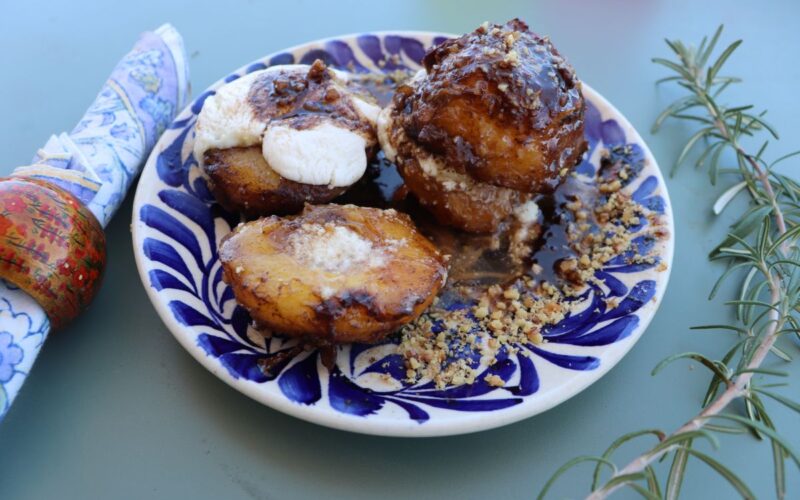There’s nothing quite as satisfying—or evocative of summer—as prising open and sinking your teeth into a perfectly ripe peach, chilled from the fridge. It beats any biscuit at teatime. Like cold watermelon, a peach is the ultimate post-beach fruit—best enjoyed when your skin is still salty and sun-kissed, and the afternoon shadows lengthen on the floor. The bruised flesh is sweet, tender, and so succulent it drips down your fingers, demanding you pause, lick, and savour. It’s gloriously messy, nostalgic of sandy childhoods spent barefoot, when time lasted forever.
This al-fresco recipe marries the sweetness of the fruit and local carob syrup with the saltiness of freshly torn mozzarella di bufala. An idea generated when camper-vanning with my cousin on Dartmoor (we had some burrata in the fridge) and stumbling upon an honesty box with an offering of peaches. That was the germ of a recipe that is otherwise all Mediterranean. The gooey starter is super-easy to make, and the undertone of cumin – warm, bitter, peppery and earthy – just takes it to another level. Cumin is my all-time favourite spice. It finds its way into everything I cook, from fried eggs to stir-fries, hummus and moussaka. I’ve given up buying small spice sprinklers. Instead, a massive tub of ground cumin sits next to my cooker.
Cumin has quite a history. Its roots can be traced to the Indus Valley and the sixth millennium BC. The Egyptian priests of Ammon, of Isis and Osiris, embalmed the mummies of their dead pharaohs with cumin seed, whilst the ancient Greeks prized the spice so much that they kept it on the table during mealtimes, ensconced in its pyxis, much as they still do today in Morocco. In ancient Rome, the spice was associated with avarice. Emperor Antonius Fulvius Pius was reviled as a ‘cumin-splitter’ for his frugality. Roman elites believed that cumin would pale the complexion when smoked or sipped in wine, so much so that the poet Horace dubbed it ‘bloodless cumin’ (exsangue cuminum). Scholars took it to appear more studious, distinguishing themselves from sun-weathered labourers.
By the Middle Ages, cumin symbolised fidelity. Brides carried it for luck, departing soldiers received cumin bread as a symbol of loyalty, and even chickens were fed it to keep them from wandering – securing its place not just in kitchens, but in courtship and coop alike.
In the Mycenaean tongue, cumin was known as ku-mi-no; the Greeks called it kyminion, the Hebrews kammon, and in Arabic, it became kammun. Closer to home, the Maltese word for cumin is kemmun—a name that lives on in the tiny island of Comino, or Kemmuna, where the spice was once cultivated.
The Sanskrit name for the spice is Jira, which means ‘that which will help digestion’. In fact, cumin is a panacea for many ills. It can restore a jaded appetite and sense of taste. Mashed together with bananas, it is a cure for insomnia. The spice can also help regulate blood sugar levels, fight tumour growth, boost a flailing immune system, prevent epileptic fits, and, when combined with fennel, assist lactating mothers in producing milk.
Moving on to the star of the show. Originating in China in the third millennium, the peach was regarded as magical, protecting from evil spirits and lightning, and its blossom was the symbol of virginity. From China, the fleshy fruit travelled to Persia, and as a result, it was known as malum persicum, the Persian apple, when it reached Rome in the time of Emperor Augustus. Persicum became pesca in Italian and pêche in French. The downy peach came into its own during the Renaissance. Forty different varieties were grown, many featuring lascivious names such as Téton de Vénus (nipple of Venus). The phrase ‘peaches and cream’ is often used to describe a flawless, radiant complexion—smooth, soft, and glowing. Meanwhile, the luscious curves of a peach have long been a playful stand-in for a shapely derrière.
Now, on with the recipe!

Ingredients
Two peaches per person (select peaches that are not too hard or too soft)
Butter or vegan butter
Pinch of nutmeg (or cinnamon)
Pinch of cumin
Crushed hazelnuts
A couple of sprigs of fresh rosemary
Black pepper
Pinch of Himalayan or sea salt.
Carob syrup (julep tal-ħarrub) or honey
Burrata (or mozzarella) di bufala or vegan ricotta
Balsamic vinegar
Method
Peel the peaches and slice them in half, gently prising out the stones. Tear the burrata/ cut the mozzarella di bufala into 1cm rounds. Lightly toast the hazelnuts in a dry pan until just golden and remove.
In the same pan, melt the butter and add your spices. Once the butter begins to sizzle (but not brown), place the peach halves cut-side down. Drizzle over a few spoonfuls of carob syrup and tuck in the rosemary sprigs. Reduce the heat and let everything gently bubble for 3–4 minutes. Flip the peaches so their curved sides are down. You’re aiming for them to soften slightly while keeping their shape.
Stir half the crushed hazelnuts into the syrupy butter. Cover the pan for another 3 minutes, then uncover for the final minute to let the sauce reduce slightly. Top half of the peach halves with a slice of the milky burrata, to warm slightly. Give the cheese a light misting of balsamic vinegar.
Take the pan off the heat and lift out the rosemary. Carefully cap each cheesy peach with a second half to create little ‘sandwiches.’ Transfer to a plate, spoon over any remaining syrup from the pan, and finish with a scattering of the reserved hazelnuts.

See Warren’s other recipes and follow his delicious forays into food heritage here.
Curious by nature and committed to sustainability, Warren is a content writer, globe-trotter, and heritage interpreter who believes our shared history lives in the meals we remember and the journeys we take to find them. Follow the thread at warreninwords.com.










